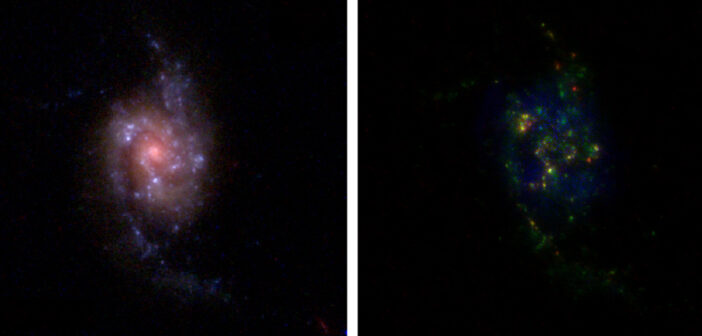To track down galaxies in the early universe, astronomers search for Lyman-alpha emission, which is generated by electrons in hydrogen atoms sliding down to their lowest energy level. Although this method is commonly used to find galaxies, it can be difficult to link the properties of the Lyman-alpha emission to those of the galaxy because the photons are are absorbed, scattered, and re-emitted as they travel from their birthplaces in the surroundings of hot, young stars to our telescopes. To understand how Lyman-alpha emission reflects the properties of distant galaxies, Jens Melinder (Stockholm University) and collaborators surveyed Lyman-alpha-emitting galaxies in the nearby universe. The team observed 45 nearby galaxies with the Hubble Space Telescope and used models to determine their properties. The images above show one galaxy from the sample in two ways: the left-hand image shows the stellar continuum emission captured by Hubble’s broad filters, while the right-hand image shows a combination of ultraviolet stellar emission and narrow emission lines (including Lyman alpha in blue) from glowing hydrogen gas. Using these observations, the team determined that the dustier the galaxy, the less Lyman-alpha emission makes it to our telescopes, and the same may be true for galaxies containing more stars. To learn more about the results of this survey, be sure to read the full article linked below.
Citation
“The Lyα Reference Sample. XIV. Lyα Imaging of 45 Low-redshift Star-forming Galaxies and Inferences on Global Emission,” Jens Melinder et al 2023 ApJS 266 15. doi:10.3847/1538-4365/acc2b8
